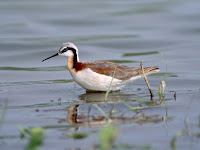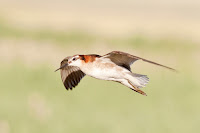WILSON'S PHALAROPE
WILSON’S PHALAROPE (Phalaropus tricolor) – (See images below)
DESCRIPTION: The Wilson’s Phalarope breeding female has a grey head crown and a grey back with reddish sides. There is a black band starting from the bill base, going through the eye and extending down the neck. Throat and undersides are white. There is a small white supraciliar band. Male has duller colors and no reddish plumage. Bill is fine and slightly longer than the head and black. Females are slightly larger than males. Legs and lobed feet are dark yellow. Bird length is about 23 cm (9 inches).
VOICE: https://www.xeno-canto.org/species/Phalaropus-tricolor
NAME: ‘Phalarope’ (also Latin ‘Phalaropus’) refers to ‘Coot’ and ‘foot’. ‘Wilson’s’ was given to bird in honor of Scottish-American ornithologist Alexander Wilson. Latin species name ‘tricolor’ refers to female’s plumage.
HABITAT: Prefers saltwater wetlands.
DIET: Insects and crustaceans. Swims in a circle to create a whirlpool, thus attracting bottom prey near surface.
NESTING: Nest is located on the ground near water. Chosen by female, arranged by male. About four beige eggs are laid, incubated by male. Chicks can feed themselves, cared for by the father.
DISTRIBUTION: Breeds in western Canada (except British Columbia coast) and norwthwest USA, also around Great Lakes. Migrates south to west coast of South America and Argentina for the winter. Some individuals will make it to Hawaii, and even New Zealand (see note below on bird vagrancy).
Distribution Map: https://en.wikipedia.org/wiki/Wilson%27s_phalarope#/media/File:Phalaropus_tricolor_map.svg
ON PEI: Does not breed on Prince Edward Island, sightings occasional in spring and summer.
CONSERVATION: Still abundand and widespread in spite of some Prairie habitat loss, currently not at risk.
NOTES: In this species it is the female that shows the more colorful plumage, chooses and defends breeding territory, courts the male and leaves incubation and chick care to the male.
Often associates with red-necked phalaropes when migrating.
Vagrancy: In biology this means an animal going way outside its normal range. For birds, this can happen when there are storms and they get blown off course. On other times, the bird simply wanders in a different direction than usual. Here’s an article about vagrancy in birds.
SIMILAR SPECIES: Red Phalarope
REFERENCES: https://en.wikipedia.org/wiki/Wilson%27s_phalarope
https://www.allaboutbirds.org/guide/Wilsons_Phalarope
http://nzbirdsonline.org.nz/species/wilsons-phalarope (New Zealand Birds Online)
https://txtbba.tamu.edu/species-accounts/wilsons-phalarope/ (Texas Breeding Bird Atlas)
https://www.allaboutbirds.org/guide/Wilsons_Phalarope/id
https://www.audubon.org/field-guide/bird/wilsons-phalarope
https://mnbirdatlas.org/species/wilsons-phalarope/ (Minnesota Breeding Bird Atlas)
https://nhpbs.org/wild/wilsonsphalarope.asp (New Hampshire PBS)
DESCRIPTION: The Wilson’s Phalarope breeding female has a grey head crown and a grey back with reddish sides. There is a black band starting from the bill base, going through the eye and extending down the neck. Throat and undersides are white. There is a small white supraciliar band. Male has duller colors and no reddish plumage. Bill is fine and slightly longer than the head and black. Females are slightly larger than males. Legs and lobed feet are dark yellow. Bird length is about 23 cm (9 inches).
VOICE: https://www.xeno-canto.org/species/Phalaropus-tricolor
NAME: ‘Phalarope’ (also Latin ‘Phalaropus’) refers to ‘Coot’ and ‘foot’. ‘Wilson’s’ was given to bird in honor of Scottish-American ornithologist Alexander Wilson. Latin species name ‘tricolor’ refers to female’s plumage.
HABITAT: Prefers saltwater wetlands.
DIET: Insects and crustaceans. Swims in a circle to create a whirlpool, thus attracting bottom prey near surface.
NESTING: Nest is located on the ground near water. Chosen by female, arranged by male. About four beige eggs are laid, incubated by male. Chicks can feed themselves, cared for by the father.
DISTRIBUTION: Breeds in western Canada (except British Columbia coast) and norwthwest USA, also around Great Lakes. Migrates south to west coast of South America and Argentina for the winter. Some individuals will make it to Hawaii, and even New Zealand (see note below on bird vagrancy).
Distribution Map: https://en.wikipedia.org/wiki/Wilson%27s_phalarope#/media/File:Phalaropus_tricolor_map.svg
ON PEI: Does not breed on Prince Edward Island, sightings occasional in spring and summer.
CONSERVATION: Still abundand and widespread in spite of some Prairie habitat loss, currently not at risk.
NOTES: In this species it is the female that shows the more colorful plumage, chooses and defends breeding territory, courts the male and leaves incubation and chick care to the male.
Often associates with red-necked phalaropes when migrating.
Vagrancy: In biology this means an animal going way outside its normal range. For birds, this can happen when there are storms and they get blown off course. On other times, the bird simply wanders in a different direction than usual. Here’s an article about vagrancy in birds.
SIMILAR SPECIES: Red Phalarope
REFERENCES: https://en.wikipedia.org/wiki/Wilson%27s_phalarope
https://www.allaboutbirds.org/guide/Wilsons_Phalarope
http://nzbirdsonline.org.nz/species/wilsons-phalarope (New Zealand Birds Online)
https://txtbba.tamu.edu/species-accounts/wilsons-phalarope/ (Texas Breeding Bird Atlas)
https://www.allaboutbirds.org/guide/Wilsons_Phalarope/id
https://www.audubon.org/field-guide/bird/wilsons-phalarope
https://mnbirdatlas.org/species/wilsons-phalarope/ (Minnesota Breeding Bird Atlas)
https://nhpbs.org/wild/wilsonsphalarope.asp (New Hampshire PBS)
 |
| Wilson's phalarope female in breeding plumage, by Dominic Sherony |
 |
| Wilson's phalaropes, by Greg Schechter |
 |
| Wilson's phalarope male, by Bill Bouton |
 |
| Wilson's phalarope male faking injury photo by USFWS, Bowdoin NWR, MT |